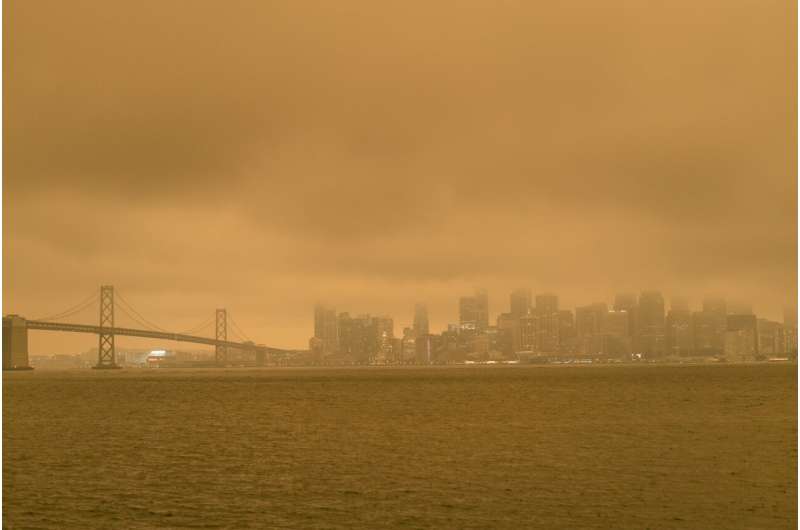
Each additional day of exposure to wildfire smoke and other extreme forms of dirty air boosts the risk of mental illness in youth a little more, according to a new University of Colorado Boulder study of 10,000 9- to 11-year-olds.
“We found that a greater number of days with fine particulate air pollution levels above EPA standards was associated with increased symptoms of mental illness, both during the year of exposure and up to one year later,” said first author Harry Smolker, a research associate with CU’s Institute of Cognitive Science.
The study, published in Environmental Health Perspectives, comes as smoke from Southern California fires blankets much of the West, thickening skies as far away as Las Vegas and parts of Colorado.
While annual average air quality has generally improved in recent decades due to limits on emissions from combustion engines and industry, more frequent fires like this have created a new problem: more days with severe levels of tiny particles of burnt things—aka particulate matter—in the air.
“We are entering a new age in which we are experiencing unprecedented levels of exposure to particulates multiple times a year,” said Smolker. “We need to understand what these extreme events are doing to young people, their brains and their behavior.”
The pollution, mental health link
While scientists have known for years that air pollution can harm lung and heart health, they’ve only recently begun to explore its impact on cognition and behavior.
Some studies show that PM2.5, particulate matter with a diameter of less than 2.5 micrometers, may be small enough to slip across the blood-brain barrier, inflaming tissue, damaging cells and igniting an immune response that can fuel both acute and longer-term brain changes.
Hospital admissions for depression, suicide attempts and psychotic episodes have been shown to increase in adults on high pollution days. And when pregnant people are exposed to high levels of particulates, their children are more likely to have motor deficits and cognitive impairments later in life, studies suggest.
Smolker’s study is among the first to look at potential impacts on adolescents, whose brains are still developing.
The team analyzed data from 10,000 pre-teens participating in the ongoing Adolescent Brain Cognitive Development (ABCD) Study— the largest long-term study of brain development and child health ever conducted in the United States. CU Boulder is one of 21 ABCD research sites.
They looked at participant addresses and historical air quality data to determine how many days in 2016 youth were exposed to PM2.5 levels above 35 micrograms per cubic meter (35ug/m3)—the level the Environmental Protection Agency deems unsafe.
About one-third were exposed to at least one day above the EPA standard. One participant was exposed to unsafe levels for 173 days. The highest level of exposure reported was 199 micrograms/m3—more than five times the level deemed safe.
When looking at parent questionnaires at four time points over three years, the researchers found that, across both genders, each additional day of exposure at unsafe levels boosted the likelihood of a youth having symptoms of depression, anxiety and other “internalizing symptoms” up to one year later.
This was after accounting for a wide variety of potentially confounding factors, including race, socioeconomic status and, notably, parental mental health. Even when parents did not report symptoms themselves, they often reported higher symptoms in their children.
“This suggests that PM2.5 exposure may have specific impacts on youth distinct from impacts on their parents,” Smolker said.
Each day counts
Repeated high levels of exposure had a far greater influence on risk than annual averages or maximum levels did, suggesting that each additional day of breathing poor air counts.
For each day of unsafe exposure, risk went up .01 points on average on a scale of 1 to 64.
“This is relatively small, but not trivial,” Smolker said, noting that PM2.5 is just one of the myriad pollutants in the “exposome”—the collection of environmental exposures that shape children’s development. “Collectively they can add up.”
Some youth may be genetically predisposed to be even more vulnerable to the impacts of air pollution, he notes.
While particulate matter can emerge from many sources, including traffic and industry, study co-author Colleen Reid, a geographer with the Institute for Behavioral Science, suspects that most of the unsafe exposures identified in the study were due at least in part to wildfire smoke.
“Wildfire smoke events are becoming more and more common, and this study adds to a growing body of evidence that they can impact our health,” Reid said.
More information:
Harry R. Smolker et al, The Association between Exposure to Fine Particulate Air Pollution and the Trajectory of Internalizing and Externalizing Behaviors during Late Childhood and Early Adolescence: Evidence from the Adolescent Brain Cognitive Development (ABCD) Study, Environmental Health Perspectives (2024). DOI: 10.1289/EHP13427
Citation:
Wildfire smoke exposure boosts risk of mental illness in youth, researchers find (2024, September 12)
retrieved 13 September 2024
from https://medicalxpress.com/news/2024-09-wildfire-exposure-boosts-mental-illness.html
This document is subject to copyright. Apart from any fair dealing for the purpose of private study or research, no
part may be reproduced without the written permission. The content is provided for information purposes only.


